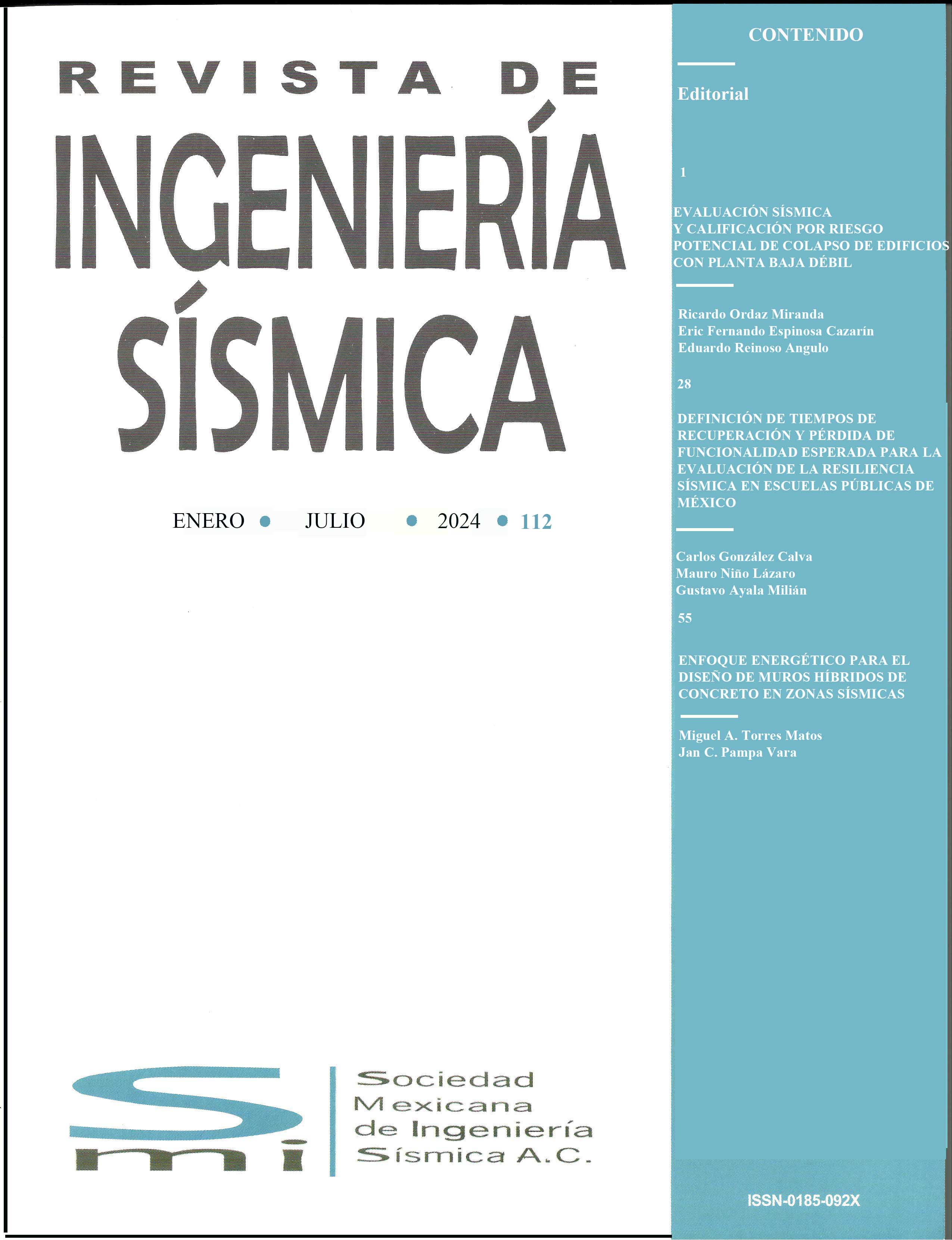OPTIMAL INELASTIC DESIGN OF REINFORCED CONCRETE FRAMES WITH BUCKLING RESTRAINED BRACES
DOI:
https://doi.org/10.18867/ris.111.640Keywords:
multi-objective design, optimization, cost, damage indexAbstract
Currently, the combination of optimization techniques with the seismic design of buildings has proven to be a great alternative to obtain optimal designs in one or more desired aspects such as cost, weight, seismic and environmental performance, among others. Likewise, the use of buckling restrained braces has gained popularity due to its outstanding contribution to seismic energy dissipation. Therefore, in the present manuscript the multi-objective design of dual systems composed by braced reinforced concrete frames with BRB is presented. The procedure is based on the Non-Dominated Sorting Genetic Algorithm (NSGA-II) optimization approach and two objective functions: initial cost and seismic performance. To evaluate the seismic performance, the average response of the structure is calculated through non-linear dynamic analysis under the action of eight narrow-band seismic records. In addition, the average local Park and Ang damage index is considered a constraint function. The approach was applied for two 9- and 12-story buildings considering the columns, beams and BRB’s sections as problem variables. The results demonstrate the efficiency of the application of NSGA-II technique in the non-linear seismic design of dual systems to achieve economical, lightweight and safe designs sets quickly and efficiently.
Downloads
References
Bakhshinezhad, D y M Mohebibi (2020), “Multi-objective optimal design of semi-active fluid viscous dampers for nonlinear structures using NSGA-II”, Structures, Vol. 24, pp. 678-679. DOI: 10.1016/j.istruc.2020.02.004
Black, C, N Makris y I Aiken (2002), “Component testing, stability analysis and characterization of buckling-restrained unbounded braces”. Technical Report PEER 2002/08, Pacific Earthquake Engineering Research Center, University of California, Berkeley, pp. 880-894.
Barraza, M, E Bojórquez, E Fernández y A Reyes-Salazar (2017), “Multi-objective optimization of structural steel buildings under earthquake loads using NSGA-II and PSO”, KSCE Journal of Civil Engineering, Vol. 21, No. 2, pp. 488-500 DOI: 10.1007/s12205-017-1488-7
Bojórquez, E, A Reyes-Salazar, S Ruiz y J Bojórquez (2013), “A new spectral shape-based record selection approach using Np and genetic algorithms”, Mathematical Problems in Engineering, Vol. 2013. DOI: 10.1155/2013/679026
Chang, Y, Z Bouzarkouna y D Devegowda (2015), “Multi-objective optimization for rapid and robust optimal oilfield development under geological uncertainty”, Vol. 19, No. 4, pp. 933-950. DOI:10.1007/s10596-015-9507-6
Deb, K, A Pratap, S Agarwal Y T Meyarivan (2002), “A fast and elitist multiobjective genetic algorithm: NSGA-II”, IEEE Transactions on evolutionary computation, Vol. 6, No. 2, pp. 182-197. DOI: 10.1109/4235.996017
Dorigo, M, V Maniezzo y A Colorni (1996), “Ant system: optimization by a colony of cooperating agents”, IEEE Transactions on Systems, Man, and Cybernetics, Part B (Cybernetics), Vol. 26, No. 1, pp. 29-41. DOI: 10.1109/3477.484436
Erol, O, y I Eksin (2006), “A new optimization method: Big Bang-Big Crunch”, Advances in Engineering Software, Vol. 37, pp. 106-111. DOI: 10.1016/j.advengsoft.2005.04.005
Galvis, G, E Miranda, P Heresi, H Davalos y J Silos (2017), “Preliminary statistics of collapsed buildings in Mexico City in the September 19, 2017 Puebla-Morelos earthquake”, Department of Civil and Environmental Engineering, Stanford University, Technical Report.
Gholizadeh, S y F Fattahi (2021), “Multi-objetive design optimization of steel moment frames considering seismic collapse safety”, Engineering with Computers, Vol. 37, pp. 1315-1328. DOI: 10.1007/s00366-019-00886-y
Gkournelos, P, T Triantafillou y D Bournas (2021), “Seismic upgrading of existing reinforced concrete buildings: A state-of-the-art review”, Engineering Structures, Vol. 240. DOI: 10.1016/j.engstruct.2021.112273
Katoh, T, M Iwata y A Wada. (2002), “Performance evaluation of buckling-restrained braces in damage-controlled structures”, Journal of Structural and Construction Engineering, Vol. 67, pp. 101-108. DOI: 10.1201/9780203738290-6
Katsanos, E, A Sextos y G Manolis (2010), “Selection of earthquake ground motion records: A state-of-the-art review from a structural engineering perspective”, Soil Dyn. and Earth. Eng. Vol. 30, pp. 157-169. DOI: 10.1016/j.soildyn.2009.10.005
Kennedy, J y R Eberhart (1995), “Particle Swarm Optimization”, Proceedings of ICNN’95 International Conference on Neural Networks, Vol. 4, PP. 1942-1948. DOI: 10.1109/ICNN.1995.488968
Leyva, H, E Bojórquez, J Bojórquez, A Reyes-Salazar, J Castorena, E Fernández y M Barraza (2018), “Earthquake design of reinforced concrete buildings using NSGA-II”, Advances in Civil Engineering, Vol. 2018. DOI: 10.1155/2018/5906279
Leyva, H, J Bojórquez, E Bojórquez, A Reyes-Salazar, J Carrillo y F López-Almansa (2021), “Multi-objective seismic design of BRBs-reinforced concrete buildings using genetic algorithms”, Structural and Multidisciplinary Optimization, Vol. 64, No. 4, pp. 2097-2112. DOI: 10.1007/s00158-021-02965-5
Meli, R y E Miranda (1986), “Evaluación de los efectos de los sismos de septiembre de 1985 en los edificios de la Ciudad de México. Parte 1: Evaluación de daños”, Instituto de Ingeniería, UNAM, Vol 2-1.
Merrit, S, C Uang y G Benzoni (2003), Subassemblage testing of corebrace buckling-restrained braces, La Jolla, California: University of California, San Diego.
Park, Y y A Ang (1985), “Mechanistic seismic damage model for reinforced concrete”, Journal of Structural Engineering, Vol. 111, No. 4, pp. 722-739. DOI: 10.1061/(ASCE)0733-9445(1985)111:4(722)
Rahimbakhsh, H, M Kohansal, A Tarkashvand, M Faizi y M Rahbar (2022), “Multi-objective optimization of natural surveillance and privacy in early design stages utilizing NSGA-II”, Automation in Construction, Vol. 143. DOI: 10.1016/j.autcon.2022.104547
Rezazadeh, F y S Talatahari (2020), “Seismic energy-based design of BRB frames using multi-objective vibrating particles system optimization”, Structures, Vol. 24, pp. 227-239. DOI: 10.1016/j.istruc.2020.01.006
Takeda, T, M Sozen y N Nielsen (1970), “Reinforced concrete response to simulated earthquakes”, Journal of the Structural Division, ASCE, Vol. 96, No. 12, pp. 2557-2573. DOI: 10.1061/JSDEAG.0002765
Terán-Gilmore, A y J Jirsa (2005), “A damage model for practical seismic design that accounts for low cycle fatigue”, Earthquake Spectra, Vol. 21, No. 3. DOI: 10.1193/1.1979500
Terán-Gilmore, A y J Ruiz-García (2011), “Comparative seismic performance of steel frames retrofitted with buckling-restrained braces through the application of Force-Based and Displacement-Based approaches”, Soil Dynamic and Earthquake Engineering, Vol. 31, No. 3, pp. 478-490. DOI: 10.1016/j.soildyn.2010.11.003
Xue, Q, Z Wang y Q Chen (2022), “Multi-objective optimization of building design for life cycle cost and CO2 emissions: A case study of a low-energy residential building in a severe cold climate”, Building Simulation, Vol. 15, pp. 83-98, 2022. DOI: 10.1007/s12273-021-0796-5
Zhou, Y, H Shao, Y Cao y E Lui (2021), “Application of buckling-restrained braces to earthquake-resistant design of buildings: A review”, Engineering Structures, Vol. 146. DOI: 10.1016/j.engstruct.2021.112991
Carr, A (2015), “Volume 3: User manual for the 3-Dimensional Version Ruaumoko3D”, Department of Civil Engineering, University of Canterbury, New Zealand.

Published
How to Cite
Issue
Section
License
Copyright (c) 2024 Journal Earthquake Engineering

This work is licensed under a Creative Commons Attribution-NonCommercial 4.0 International License.





